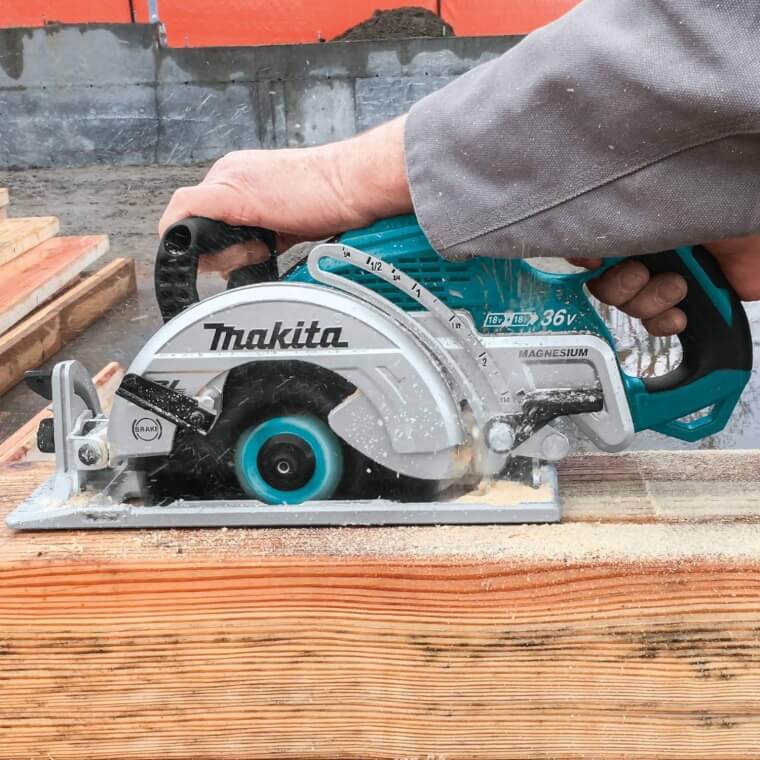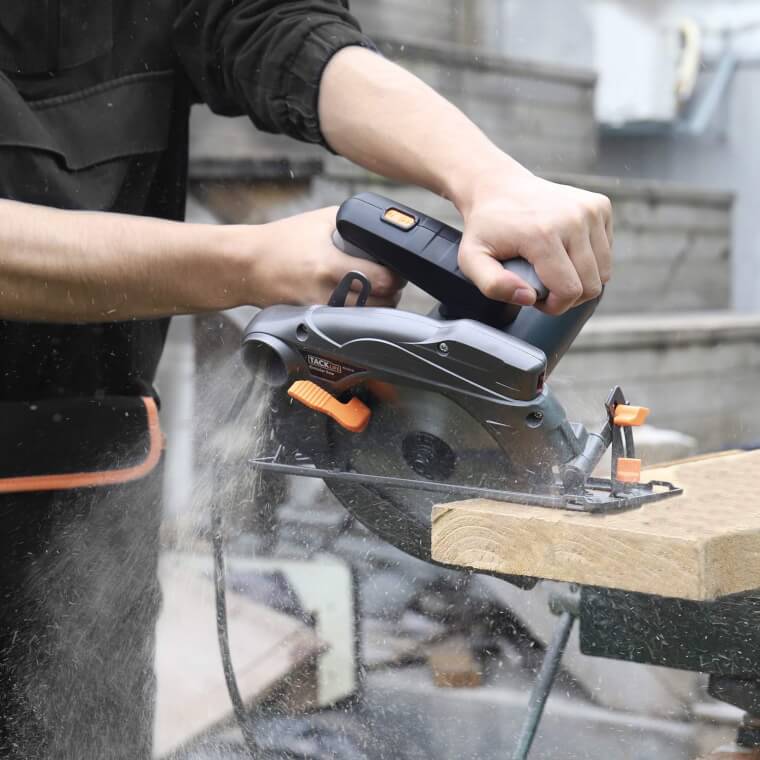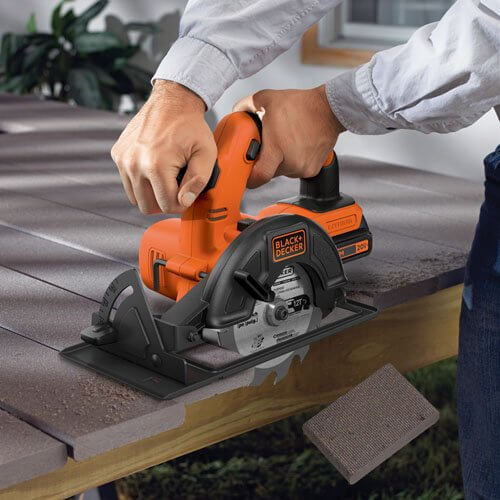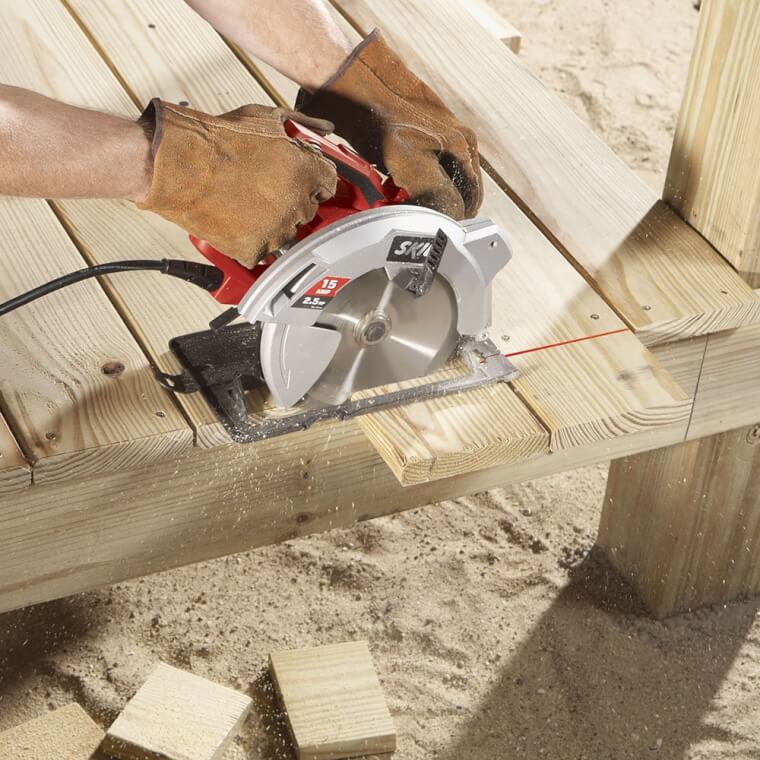A Circular saw is a hand-held power tool predominantly used for cutting wood. However, there are also various different blades available that enable the saw to cut through plastic and metal as well. For a powerful and accurate cut, there is nothing better!
So, back to the question at hand, corded or cordless? This is not an easy decision to make, however, there are a few key differences between the two that, depending on your needs, should sway you one way or the other. Let’s delve into these differences and hopefully help you make your decision along the way!
Cordless Circular Saws
What if you need to work outside and don’t have access to a power outlet or have an extension lead? Enter a cordless circular saw.
The cordless option offers the user complete freedom as they can be used anywhere. Need to make a quick cut in the garden, no problem, a cordless saw has you covered. You also won’t have to worry about fighting with the power cord or catching it on something, leading to a miss-cut or potentially cutting through the cord itself.
Pros of going cordless
In recent years cordless saws have become a lot lighter, more powerful and longer lasting. Many professionals are switching over to cordless as they have become just as efficient. Latest models are now offering the same 7 ¼” blade size as the corded versions, and have use time of around 8 hours!
For example, the DEWALT DCS577X1 is a 60v brushless cordless circular saw that is lighter than many top corded circular saws, just as powerful and has a 9.0Ah battery.
All the latest models now use a standard strange of battery packs, so if you are already invested in DEWALT for example, you may already have the correct battery pack, meaning you can buy the tool-only version to save money.
When shopping for a cordless circular saw look for newer models with a blade size in the range of 6-3/8″ to 7 ¼”.
Cons of cordless
As with the corded variety, there are a few drawbacks to a cordless circular saw, however, these drawbacks have become LESS of a problem with the latest models as the batteries are really good now.
If you are opting for an older model, then an obvious issue is the need for a fresh battery in long periods of use. During use as the battery drains the saw can become less powerful. Having to change the battery to maintain peak power can be annoying.
Another issue is that over time these batteries age and will eventually need replacing. Although this may take some time, it is still more money out of your pocket down the line which is something you must consider. Finally, the addition of the onboard battery adds to the overall weight of the saw, making some cordless saws heavier for the user and potentially leading to quicker user fatigue.
Which is the best cordless model?
We put together a list of the top cordless circular saws here. We listed top end models for contractors down to cheap options for those on a budget.
What is a brushless circular saw?

Brushless tools have gained popularity in recent years within the power tool industry, but what are they and is this rise in popularity warranted? The term ‘brushless’ refers to the brushless motor technology used in these tools. Brushless tools adjust their power output to the task at hand, meaning the more resistance the tool detects, the more power it produces. The result is a motor that does not experience any voltage drops or friction which can increase the longevity of the motor.
With this advancement in technology comes an increase in the manufacturing costs. On average they tend to be 30% more expensive than cordless tools with standard lithium-ion batteries. Although off-putting to average users, brushless tools are still very appealing to professionals who use and rely on their tools daily.
Corded Circular Saws
Pros of Corded Models
The main benefits of a corded circular saw is broken down to 4 things:
- Power
- Consistency of power
- Price
- Larger blades
Drawing its energy from the mains means it can maintain the same level of power throughout use with zero dips in performance, making it super reliable during long and tough jobs.
With all its power needs coming from an external resource the saw itself doesn’t need to house a battery, making it lighter and less fatigue-inducing than many of the cordless options. This makes it ideal for home DIYer or those on budget, as they are generally more affordable than the battery-powered saws.
With the added power available, corded circular saws typically use a larger blade. Typically blade size is 7 ¼”, however, they can go up to 10-1/4″ for those needing the extra capacity – this is something not available on the cordless models (yet anyway!).
Cons of Corded Models
Of course, there are a few drawbacks that come with a corded circular saw, the first of which is its lack of mobility and constricted movement. The need to be plugged into a power outlet may restrict the number of jobs you are able to perform and make you plan ahead depending on power outlet accessibility. As with any corded power tool, there is also the threat of cutting through the power cable during use which is a hazard the user must be aware of at all times.
Which one is best to buy?
Take a look at our guide on the top circular saws here. We run down a list of the very best to cheap models depending on your budget.
How to make your Decision
Of course, when it comes to making your decision price plays a large role. Both corded and cordless circular saws vary greatly in price depending on the quality of saw you’re after. It is also important to remember high-end cordless saws can be more than you expect with the added cost of batteries and a charger. Along with the price, your decision will be dictated by your profession, what jobs you intend to use your saw for and where you intend to use it.

Home DIYers: If you predominantly work out of your home workshop then a corded circular saw should suit you just fine. Even working around the house you should be within reach of a power outlet to power your saw. Going with a reasonably priced corded circular saw will save you money and do the job just fine!
If you have any doubt it is a good idea to go with the cordless option. At least then you will have peace of mind knowing you can work from anywhere without an issue!


Reader Interactions